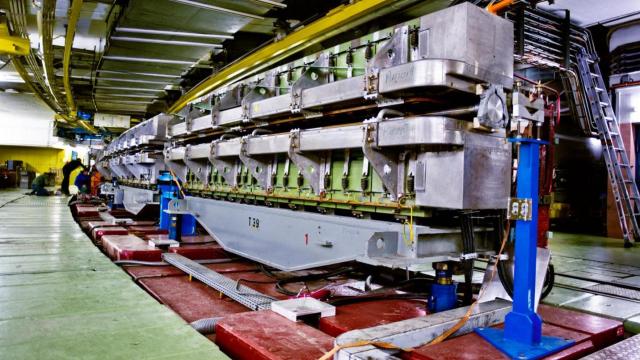The oldest particle accelerator at CERN, home to the world’s most powerful particle accelerator, is celebrating its 60th birthday. It’s still running.
The Proton Synchrotron (PS) accelerated its first protons on November 24, 1959. It was the world’s highest-energy accelerator when it first began running. Though it’s since lost the title but today supplies protons or heavy ions to a number of particle physics experiments, including the Large Hadron Collider (which currently holds the title as the largest and highest-energy accelerator).
CERN was established in 1954 for peaceful study of particle and nuclear physics, and the PS was among its first planned projects. Scientists were inspired by a visit to Brookhaven National Lab to build a synchrotron based on the alternating gradient principle in order to build a higher-energy accelerator. A synchrotron takes injected particles and bends them along a circular path using magnetic fields slowly ramped up and synchronised with the energy of the particles. The alternating gradient principle was a means to focus the beam of particles by using alternating quadrupole magnets—imagine four magnets with alternating poles aligned in a plus sign shape.
As with any accelerator, it was a challenge actually getting the thing up and running. At one point, scientists got the protons to go around once, but then that was it. They couldn’t get them to keep going around for weeks until finally all the small little adjustments combined got it to work not just well but at the designed energy. You can read a full account from 1969 written by Canadian physicist Hildred Blewett here. But it was an exciting time once it actually turned on and worked.
“I’m told that I screamed, the first sound, but all I remember is laughing and crying and everyone there shouting at once, pumping each other’s hands, clapping each other on the back while I was hugging them all. And the beam went on, pulse after pulse,” Blewett, who worked with other physicists to get it to that point, wrote.
The PS accepts protons from a proton source (basically a bottle of hydrogen gas) first accelerated through another linear accelerator. The alternating magnets would send the protons around its 628-metre (2060-foot) circumference to 25 giga electron-volts.
That’s about as much energy as it takes to lift a grain of sand a tenth of an inch, but it’s also 25 times the rest mass of the proton, enough to begin exploring the higher-energy realm of physics previously unaccessible to experiments. In the first five years after the PS’ construction, it (and other similar accelerators of the era) uncovered a multitude of new particles to make sense of.
Scientists attached new, larger accelerators and colliders to the PS as time went on, juicing up the energy of these colliders in search of more subatomic particles. They were driven in part by a theory called the Standard Model of particle physics. Soon the PS was supplying protons to the 400 GeV Super Proton Synchrotron, which in turn accelerated and supplied protons to the Large Electron–Positron Collider and now the Large Hadron Collider, the largest physics experiment ever built.
The PS’ importance means it continues to be upgraded and maintained. It’s currently on a temporary shutdown for work. Forty-eight of its 100 magnets are in the midst of being renovated. Scientists are cleaning the accelerator, and replacing pumps and and three kilometres of pipes in the instrument’s cooling system. Not a bad birthday gift.
So, happy 60th birthday to the Proton Synchrotron, particle physics wouldn’t be the same without you!
